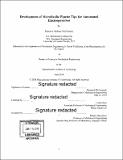| dc.contributor.advisor | Cullen Buie. | en_US |
| dc.contributor.author | McCormack, Rameech Nashana | en_US |
| dc.contributor.other | Massachusetts Institute of Technology. Department of Mechanical Engineering. | en_US |
| dc.date.accessioned | 2018-11-15T16:36:20Z | |
| dc.date.available | 2018-11-15T16:36:20Z | |
| dc.date.copyright | 2018 | en_US |
| dc.date.issued | 2018 | en_US |
| dc.identifier.uri | http://hdl.handle.net/1721.1/119095 | |
| dc.description | Thesis: S.M., Massachusetts Institute of Technology, Department of Mechanical Engineering, 2018. | en_US |
| dc.description | Cataloged from PDF version of thesis. | en_US |
| dc.description | Includes bibliographical references (page 72). | en_US |
| dc.description.abstract | Genetic engineering and synthetic biology are often used to create microorganism that can produce novel pharmaceuticals, biofuels, and other high value compounds. One of the biggest challenges to advancing the field is the difficulty at which exogenous material is transferred to the cells. Flow-through microfluidic technology has been shown to improve the transformation efficiency and the potential to increase the rate of cell transfection approximately 10,000X the current state of the art. The next step in engineering the process is to scale the microfluidic technology to one that can be incorporated into a high volume genetic engineering environment similar to those used in industry. In this thesis, the development of a high throughput, scalable design is undertaken. Various iterations of the design scheme are taken into account, such as a continuous-flow design for high volume genetic engineering and a microfluidic pipette that interfaces with preexisting liquid handling systems. The design efficacy is also confirmed with experimental tests. The microfluidic pipette tips out-perform the current state of the art (cuvettes) technology. The maximum output transformation efficiency of Escherichia coli DH10[beta], for the fabricated microfluidic pipette tips, is 6.4x10⁹ colony forming units per micro-gram of DNA (CFU/[mu]gDNA).The maximum output performance of the cuvette electroporation process was 2.5x10⁹ CFU/([mu]gDNA). The performance of the microfluidic tips is 2.5X the output efficiency of the cuvettes at the same applied potential difference and DNA concentration. Further experiments studied the effects of polarity and applied waveform on the transformation efficiency of Escherichia coli DH10[beta]. Results of this work indicate that a unipolar waveform and negative polarities increase the transformation efficiency. | en_US |
| dc.description.statementofresponsibility | by Rameech Nashana McCormack. | en_US |
| dc.format.extent | 72 pages | en_US |
| dc.language.iso | eng | en_US |
| dc.publisher | Massachusetts Institute of Technology | en_US |
| dc.rights | MIT theses are protected by copyright. They may be viewed, downloaded, or printed from this source but further reproduction or distribution in any format is prohibited without written permission. | en_US |
| dc.rights.uri | http://dspace.mit.edu/handle/1721.1/7582 | en_US |
| dc.subject | Mechanical Engineering. | en_US |
| dc.title | Development of microfluidic pipette tips for automated electroporation | en_US |
| dc.type | Thesis | en_US |
| dc.description.degree | S.M. | en_US |
| dc.contributor.department | Massachusetts Institute of Technology. Department of Mechanical Engineering | |
| dc.identifier.oclc | 1059453017 | en_US |
